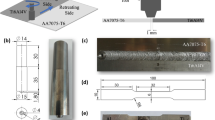Abstract
The microstructure and mechanical properties of dissimilar pinless friction stir spot welded joint of 2A12 aluminum alloy and TC4 titanium alloy were evaluated. The results show that the joint of Al/Ti dissimilar alloys can be successfully attained through pinless friction stir spot welding (FSSW). The joint can be divided into three zones (SZ, TMAZ and HAZ). The microstructure of joint in Al alloy side changes significantly but it basically has no change in Ti alloy side. At the same rotation speed, the maximum load of welded joints gradually rises with the increase in dwell time. At the same dwell time, the maximum load of the welded joint increases with the increase of the rotational speed. In addition, optimal parameters were obtained in this work, and they are rotation speed of 1500 r/min, plunge speed of 30 mm/min, plunge depth of 0.3 mm and dwell time of 15 s. The fracture mode of welded joints is interfacial shear fracture. The microhardness of the joint on the Al side distributes in a typical “W” type and is symmetry along the weld center, but the distribution of the microhardness on the Ti side has no obvious change.
摘要
本文针对2A12 铝合金与TC4 钛合金,采用无针搅拌摩擦点焊工艺研究了不同工艺参数下的异 质接头的组织及性能。研究结果表明,通过无针搅拌摩擦焊可以成功获得Al/Ti 异质合金接头,并且 接头可分为三个典型的区域:搅拌区、热力影响区和热影响区。Al 侧接头的微观组织变化比较显著, 而Ti 侧组织没有明显的变化。拉剪试验的结果表明,在相同的搅拌头旋转速度下,接头的最大拉剪 载荷随停留时间的增大而增大。在同一停留时间下,转速越大接头的最大拉剪载荷也越大。此外,在 转速1500 r/min、停留时间15 s 时接头的强度最高,接头的断裂模式为界面剪切断裂。显微硬度测试 结果显示,接头Al 侧的硬度值呈典型的“W”分布并沿接头中心线对称,而Ti 侧的硬度值没有明显的 变化。
Similar content being viewed by others
References
SHEN J, LI Y, ZHANG T, PENG D, WANG D, XU D. Preheating friction stir spot welding of Mg/Al alloys in various lap configurations [J]. Science and Technology of Welding and Joining, 2015, 20(1): 1–10.
LIU J, GOU WX, LIU W, YUE Z F. Effect of hammer peening on fatigue life of aluminum alloy 2A12-T4 [J]. Materials and Design, 2009, 30: 1944–1949.
NIE Bao, ZHANG Zheng, ZHAO Zi, ZHONG Qun. Effect of anodizing treatment on the very high cycle fatigue behavior of 2A12-T4 aluminum alloy [J]. Materials and Design, 2013, 50: 1005–1010.
XU Wei, ZHANG Zhen. Microstructure and mechanical properties of laser beam welded TC4/TA15 dissimilar joints [J]. Transactions of Nonferrous Metals Society of China, 2016, 26(12): 3135–3146.
JI Shu, LI Zheng, Wang YUE, MA Lin. Joint formation and mechanical properties of back heating assisted friction stir welded Ti-6Al-4V alloy [J]. Materials and Design, 2017, 113: 37–46.
YAN Hong, ZHANG Ji, LI Lin, FENG Rui, LI Tian. Prediction of upper limit position of bedding separation overlying a coal roadway within an extra-thick coal seam [J]. Journal of Central South University, 2018, 25(2): 448–460.
JI Shu, LI Zheng, ZHANG Li, WANG Yue. Eliminating the tearing defect in Ti-6Al-4V alloy joint by back heating assisted friction stir welding [J]. Materials Letters, 2017, 188: 21–24.
SQUIRES L, LIM Y C, MILES M P, FENG Z. Mechanical properties of dissimilar metal joints composed of DP 980 steel and AA 7075-T6 [J]. Science and Technology of Welding and Joining, 2015, 20(3): 242–248.
WU Sai, GHAFFARI B, HETRICK E, LI Mei, JIA Zhi, LIU Qing. Microstructure characterization and quasi-static failure behavior of resistance spot welds of AA6111-T4 aluminum alloy [J]. Transactions of Nonferrous Metals Society of China, 2014, 24(12): 3879–3885.
TAO Jian, GONG Liang, LIU Cheng, ZHAO Yang. Multi-field dynamic modeling and numerical simulation of aluminum alloy resistance spot welding [J]. Transactions of Nonferrous Metals Society of China, 2012, 22(12): 3066–3072.
VENUKUMAR S, YALAGI S G, MUTHUKUMARAN S, KAILAS S V. Static shear strength and fatigue life of refill friction stir spot welded AA 6061-T6 sheets [J]. Science and Technology of Welding and Joining, 2014, 19(3): 214–223.
ZHANG H, WANG D, XUE P, WU L H, NI D R, MA Z Y. Microstructural evolution and pitting corrosion behavior of friction stir welded joint of high nitrogen stainless steel [J]. Materials & Design, 2016, 110: 802–810.
KAMRAN A, FARHAD G. Influence of welding speed on corrosion behaviour of friction stir welded AA5086 aluminium alloy [J]. Journal of Central South University, 2016, 23(6): 1301–1311.
WU L H, XUE P, XIAO B L, MA Z Y. Achieving superior low-temperature superplasticity for lamellar microstructure in nugget of a friction stir welded Ti-6Al-4V joint [J]. Scripta Materialia, 2016, 122: 26–30.
LIU Hui, HU Yan, DOU Chao, SEKULIC D P. An effect of the rotation speed on microstructure and mechanical properties of the friction stir welded 2060-T8 Al-Li alloy [J]. Materials Characterization, 2017, 123: 9–19.
LIU Hui, HU Yan, ZHAO Yun. Microstructural characteristics and formation mechanism of friction stir welds of SiC particulates reinforced Al–Si matrix composites [J]. Materials Letters, 2015, 158: 136–139.
SUTTON M A, REYNOLDS A P, YANG Bang, Taylor R. Mode I fracture and microstructure for 2024-T3 friction stir welds [J]. Materials Science and Engineering A, 2003, 354(1, 2): 6–16.
BAKAVOS D, PRANGNELL P B. Effect of reduced or zero pin length and anvil insulation on friction stir spot welding thin gauge 6111 automotive sheet [J]. Science and Technology of Welding and Joining, 2009, 14(5): 443–456.
LI Wen, CHU Qiang, YANG Xia. Microstructure and morphology evolution of probeless friction stir spot welded joints of aluminum alloy [J]. Journal of Materials Processing Technology, 2017, 252: 69–80.
YANG Xia, FENG Wu, LI Wen, XU Ya, CHU Qiang, MA Tie, WANG Wei. Numerical modelling and experimental investigation of thermal and material flow in probeless friction stir spot welding process of Al 2198-T8 [J]. Science and Technology of Welding and Joining, 2018, DOI: 10.1080/13621718.2018.1469832.
Author information
Authors and Affiliations
Corresponding author
Additional information
Foundation item: Projects(51405389, 51675435) supported by the National Natural Science Foundation of China; Project(3102017ZY005) supported by the Fundamental Research Funds for the Central Universities, China; Project(SAST2016043) supported by the Fund of SAST, China; Project(20161125002) supported by the Aeronautical Science Foundation of China; Project(B08040) supported by the 111 Project, China; Projects(2016YFB0701203, 2016YFB1100104) supported by the National Key Research and Development Program of China
Rights and permissions
About this article
Cite this article
Yang, Xw., Feng, Wy., Li, Wy. et al. Microstructure and mechanical properties of dissimilar pinless friction stir spot welded 2A12 aluminum alloy and TC4 titanium alloy joints. J. Cent. South Univ. 25, 3075–3084 (2018). https://doi.org/10.1007/s11771-018-3975-5
Received:
Accepted:
Published:
Issue Date:
DOI: https://doi.org/10.1007/s11771-018-3975-5




